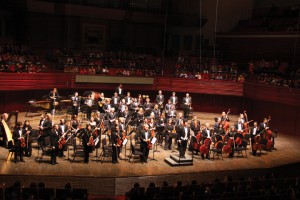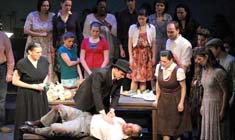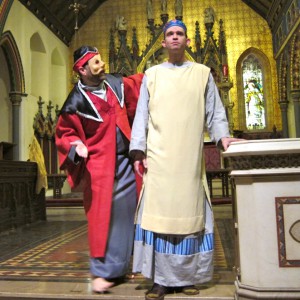At concerts presented by Musica da Camara, the sponsors of this event, this reviewer has grown to expect performances characterized by a close connection between the performers and their audience. These events are almost like family gatherings. And this was palpably present in this Emerging Artist Concert, a recital by the young Puerto Rican guitarists Enrique Velez-Bidot and Hermelindo Ruiz, which took place in the Conference Center of The American Bible Society’s New York headquarters. The audience kvelled at every sound, at every word. (To kvell – Yiddish: to take pleasure in the achievement of family members and others close to you.)
The large and enthusiastic audience loved the concert, and their pleasure did not seem to be diminished by the things I will discuss in this paragraph. Firstly, the printed program bore little connection to what we heard. I find this unacceptable, as the printed program is both a guide for the audience and an historical documentation of the event. It seems that Mr. Ruiz, after deciding to change the works he would be performing, failed to inform Musica da Camara in time. He therefore had to verbally explain the changes to the audience, thus confusing the audience and lengthening the spoken part of the recital. I know that many of today’s audiences find that spoken comments from the performers are both enjoyable and informative. But to this listener it seemed that there were almost as many words coming from the stage as there were musical sounds. A little spontaneity is a good thing. To be effective, however, performer-to-audience interaction must be very well planned and timed. Tonight, five pieces which appeared on the printed program had to be omitted because too much time was spent talking. I would have loved to have heard them, especially “El coqui” by Jose Ignacio Quinton and the two Bach Inventions arranged for two guitars.
The concert’s first half belonged to Hermelindo Ruiz. He began with three of his own works, “Espacio”, “Recordando a Margot” and “Three Sketches.” On all three he exhibited a fine technique and drew many lovely colors from the instrument. The first two were written in a quite accessible style and allowed Mr. Ruiz to spin out some lovely well shaped phrases with clear articulation. The third, equally well played, was much more complex and dissonant. This was followed by the Gavotte en Rondeau from J.S. Bach’s Suite for Lute in E Major, BWV 1006a. This very popular work is part of an arrangement by the composer of movements from his Third Partita for Violin Solo, BWV 1006. Perhaps Mr. Ruiz was being too “respectful” of this work by the great master, but I felt that the performance didn’t quite dance. I would also suggest that the first dissonant note of an appoggiatura should be a bit louder than its consonant resolution.
The first half concluded with the World Premiere of a piece Mr. Ruiz commissioned for this concert, “Variaciones sobre un tema Paraguayo” (“Variations on a Paraguayan Theme”) by the Paraguayan composer Diego Sanchez Haase. Although very well performed, this work’s basic problem was that, at least on first listening, the theme (the melody, the harmony, the structure et. al.) was so complicated that during the variations one could not tell what was being varied. If the theme (everything about the original material) isn’t clear, then one cannot take joy in perceiving what the composer does with “the original stuff.” The work made great technical demands on Mr. Ruiz, but he was up to all of them.
The second half began with a performance by Enrique Velez of Andrés Segovia’s arrangement for guitar of one of the monuments of Western Classical music, the Chaconne from the Second Partita for Violin, BWV 1004 by J.S. Bach. It was, unfortunately, not a successful performance of this most difficult work. As he had to stop and retune twice in the middle of this long work, my thought was that there must have been something wrong with Mr. Velez’s instrument. And since I know that this would have unnerved any performer, I don’t think it necessary to describe the performance in any detail. But I am happy to mention that there were moments during the Bach (and in the following duet with Mr. Ruiz) that I heard examples of the quality of playing one expects from a player with Mr. Velez’s training and experience. For the concert’s last work, Messers Ruiz and Velez got together in a jaunty performance of Juan Francisco Acosta’s “Bajo la sombra de un pino”.




